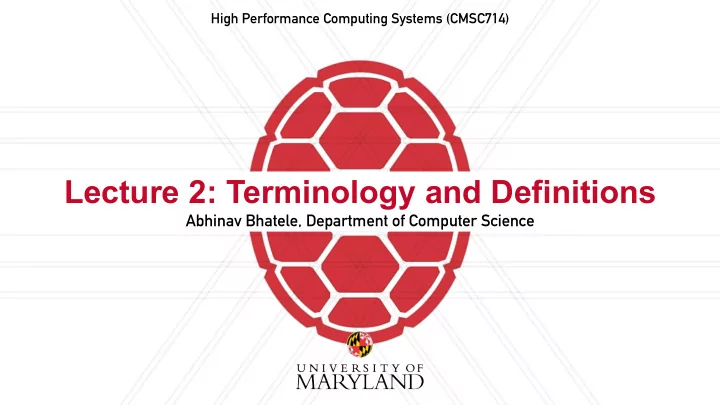

High Performance Computing Systems (CMSC714) Lecture 2: Terminology and Definitions Abhinav Bhatele, Department of Computer Science
Announcements • ELMS/Canvas page for the course is up: myelms.umd.edu • https://umd.instructure.com/courses/1273118 • Slides from previous class are now posted online • Assignments, project and midterm dates are also online Abhinav Bhatele, CMSC714 2
Summary of last lecture • Need for high performance computing • Parallel architecture: nodes, memory, network, storage • Programming models: shared memory vs. distributed • Performance and debugging tools • Systems issues: job scheduling, routing, parallel I/O, fault tolerance, power • Parallel algorithms and applications Abhinav Bhatele, CMSC714 3
Cores, sockets, nodes • CPU: processor • Single or multi-core: core is a processing unit, multiple such units on a single chip make it a multi- core processor • Socket: chip • Node: packaging of sockets https://www.glennklockwood.com/hpc-howtos/process-affinity.html Abhinav Bhatele, CMSC714 4
Serial vs. parallel code • Thread: a thread or path of execution managed by the OS • Process: heavy-weight, processes do not share resources such as memory, file descriptors etc. • Serial or sequential code: can only run on a single thread or process • Parallel code: can be run on one or more threads or processes Abhinav Bhatele, CMSC714 5
Scaling and scalable • Scaling: running a parallel program on 1 to n processes • 1, 2, 3, … , n • 1, 2, 4, 8, …, n • Scalable: A program is scalable if it’s performance improves when using more resources Abhinav Bhatele, CMSC714 6
Weak versus strong scaling • Strong scaling: Fixed total problem size as we run on more processes • Weak scaling: Fixed problem size per process but increasing total problem size as we run on more processes Abhinav Bhatele, CMSC714 7
Speedup and efficiency • Speedup: Ratio of execution time on one process to that on n processes Speedup = t 1 t n • Efficiency: Speedup per process t 1 E ffi ciency = t n × n Abhinav Bhatele, CMSC714 8
Amdahl’s law • Speedup is limited by the serial portion of the code • Often referred to as serial “bottleneck” • Lets say only a fraction p of the code can be parallelized on n processes 1 Speedup = (1 − p ) + p / n Abhinav Bhatele, CMSC714 9
Supercomputers vs. commodity clusters • Typically, supercomputer refers to customized hardware • IBM Blue Gene, Cray XT, Cray XC • Cluster refers to a parallel machine put together using off-the-shelf hardware Abhinav Bhatele, CMSC714 10
Communication and synchronization • Each physical node might compute independently for a while • When data is needed from other (remote) nodes, messaging occurs • Referred to as communication or synchronization or MPI messages • Intra-node vs. inter-node communication • Bulk synchronous programs: All processes compute simultaneously, then synchronize together Abhinav Bhatele, CMSC714 11
Different models of parallel computation • SIMD: Single Instruction Multiple Data • MIMD: Multiple Instruction Multiple Data • SPMD: Single Program Multiple Data • Typical in HPC Abhinav Bhatele, CMSC714 12
Writing parallel programs • Decide the algorithm first • Data: how to distribute data among threads/processes? • Data locality • Computation: how to divide work among threads/processes? Abhinav Bhatele, CMSC714 13
Writing parallel programs: examples • Molecular Dynamics • N-body Simulations Abhinav Bhatele, CMSC714 14
Load balance and grain size • Load balance: try to balance the amount of work (computation) assigned to different threads/ processes • Grain size: ratio of computation-to-communication • Coarse-grained vs. fine-grained Abhinav Bhatele, CMSC714 15
2D Jacobi iteration • Stencil computation • Commonly found kernel in computational codes A [ i , j ] = A [ i , j ] + A [ i − 1, j ] + A [ i + 1, j ] + A [ i , j − 1] + A [ i , j + 1] 5 Abhinav Bhatele, CMSC714 16
Questions? Abhinav Bhatele 5218 Brendan Iribe Center (IRB) / College Park, MD 20742 phone: 301.405.4507 / e-mail: bhatele@cs.umd.edu
Recommend
More recommend